Our staff are not marina hoppers. That leads to the occasional wet dinghy ride or exploration by kayak, and the constant risk of ruining expensive gear with salt water. We’ve used dry bags, Tupperware containers, dive containers, and even trash bags. Here’s what we’ve learned.
What We Tested
New bags from Gill, Mantus, and Watershed were put through their paces, alongside a pair of 35 year-old bags by Cascade Designs (now SealLine Dry Bags) and Texport from our dinghy sailing days. Also discussed are inexpensive locking food storage containers from Sistema, and purpose built dry boxes from Plano and Scuba Pro.
How We Tested
To test roll-up seals and seams, we filled the bags with towels, clothes, and gear, tied them in strings, and towed them around at idle for 10 minutes. Additionally, all of these dry bags have been in rotating use for 1 to 35 years. The smaller containers have spent countless days banging around in the bottom of kayaks and dinghies, usually in standing water and occasionally dropped overboard while boarding.
Observations
Seal vs. Roll-up. Zippers cause problems. For a fool-proof closure and seal, a roll top is hard to beat. If the bag is too big, roll it down a few more times to reduce its size. Like a figure 8 knot, it’s hard to do wrong.
Watershed recognizes the inherent durability of a roll-up closure, but backs it up with a waterproof seal, something like a super-sized zip-top baggie closure. The roll-up keeps the opening stress off the seal. Some bags use a YKK AquaSeal zipper, which you have to keep clean.
Pockets. We like an outside pocket for cell phones and wallets, but outside compartments are often not as watertight as the main compartment. Rain never dripped through the zippers, but when we towed the Gill Dry Backpack through the water for 10 minutes, a few drops snuck in. Only place waterproof items in the outside pockets if you expect more than splashes; even then a zip closure baggy is a bad idea.
Don’t over fill. The most common cause of leakage is not seam failure, but cramming so much gear into the bag that the number of rolls is reduced. In general, a minimum of 1 3⁄4 tight rolls are required if the bag might go for a serious swim. However, in the case of backpacks, a ¾ roll is enough if the pack will remain erect and all you need is to keep the gear inside and keep some light rain out.
Don’t squeeze the excess air out in an effort to compact them. Add rolls until it fits the gear and then leave it at that. The Mantus Backpack has a valve that can be used to add or subtract air; just leave it alone. If compressed, the pack will bulge back out, sucking air and water right past the rolls. Just leave the excess air in there. Watershed and Sea Line Pro Zip bags are immune to this, as long as the closure lasts.
Waterproof Bags and Boxes
| MAKER | MODEL | STYLE | VOLUME (LITERS) | COATING | MATERIAL | CLOSURE | PRICE |
|---|---|---|---|---|---|---|---|
| GILL | Cylinder Dry Bag | Stuff sack | 10 liters | PVC | 300 deneir polyester | Roll | 25 |
| KRANA | Ocean Pack | Stuff sack | 21 liters | Polyurethane | 300 deneir polyester | Roll | 30 |
| ORTLIEB | PS 490 | Stuff sack | 35 liters | Polyurethane | 1000 deneir polyester | Roll | 45 |
| SEALLINE | Discovery | Stuff sack | 20 liters | Polyurethane | 300 deneir polyester | Roll | 26 |
| ZIHK | Dry Bag | Stuff sack | 25 liters | Polyurethane | 600 deneir nylon | Roll | 25 |
| GILL | Duffel Dry Bag | Stuff sack | 30 liters | PVC | 300 deneir polyester | Roll | 58 |
| GILL | Duffel Dry Bag | Stuff sack | 60 liters | PVC | 300 deneir polyester | Roll | 75 |
| WATERSHED | Chattanooga | Duffel | 30 liters | Polyurethane | 800 deneir nylon | Seal and Roll | 121 |
| GILL | Waterproof Backpack | Backpack | 35 liters | PVC | 300 deneir polyester | Roll | 80 |
| SEA TO SUMMIT | Flow | Backpack | 26 liters | Nylon | 420 deneir nylon | Roll | 170 |
| MANTUS | Backpack | Backpack | 50 liters | Polyurethane | 840 deneir nylon | Roll | 90 |
| WATERSHED | Big Creek Pack | Backpack | 25 liters | Polyurethane | 800 deneir nylon | Seal and Roll | 156 |
| SISTEMA | Leftover container | Box | 1 liter | NA | Polypropylene | O-ring | 12 |
| PELICAN | Mini 1050 | Box | 1 liter | NA | Polypropylene | O-ring | 18 |
| PLANO | Waterproof Field Box 3500 | Box | 1 liter | NA | Polypropylene | O-ring | 16 |
| BEST DIVERS | Big Flat Canister- | Cylinder | 0.6 liter | NA | Polypropylene | O-ring | 23 |
UV damage. We’ve been using the Gill back pack for years without sign of fading, but we don’t leave it on deck. Our Cascade Designs and Texsport bags are still good after 35 years of intermittent use, nearly always out of the sun.
Occasionally small boat sailors lash a large dry bag on deck. Look for a model with strong lashing points. Watch out for chafe point on deck. Rubber matting, old neoprene, or carpet runners under the bag can prevent chafe on long voyages.
Size: Dry bags don’t have dividers so don’t buy one that is too big. We focused on 20 liter size because that is a functional size for day bags and crew bags. It also reduces the risk of getting all of your stuff wet because of one mistake.
Wet Gear. Dry bags are also good for containing wet things because they are easy to hose out. This is handy for storing wetsuits, wet, sandy towels, shells, foraged seaweed—you name it.
Ditch Bags
Commercial abandon-ship bags are generally not watertight. They’re full of pockets to organize medical and survival gear, but all those extra seams invite leaks.
We like dry bags as a supplement to your main ditch bag. The primary bag will be loaded with emergency gear; EPIRB, water, first aid, food and so forth. But there will always be items that must be collected at the last moment, and these won’t be in watertight packaging because you’re in a hurry.
- More food and water
- Medications not in the bag
- A handheld VHF
- A cell phone or Satphone in watertight case
Keep an empty dry bag next to the main ditch bag with a card on the outside reminding you of these last-minute items. I like a tether for the bag, so I can secure it to the dingy. Also internal tethers for critical gear, which are harder, but not impossible to arrange. Sew a bright color webbing loop near the bag’s lip, where it will be buried within the fold, then secure the lanyards for your smaller gear to the lip.
A dry bag will float higher than a non-waterproof bag, but it’s best to assume it will flood at some point. Putting a thick rectangle of foam in the bottom will provide flotation, support, and reduce the risk of punctures by providing padding.
Our eBook “Survival at Sea—The Complete Series,” available at our online bookstore (www.practicalsailor.com/books) offers guidance on more complete preparations.
Even car keys are electronics these days, so you’ll still want a compact dry option for dinghy rides to keep your valuables dry. We’ve tried the expensive brands, but found there are plenty of cheaper options.
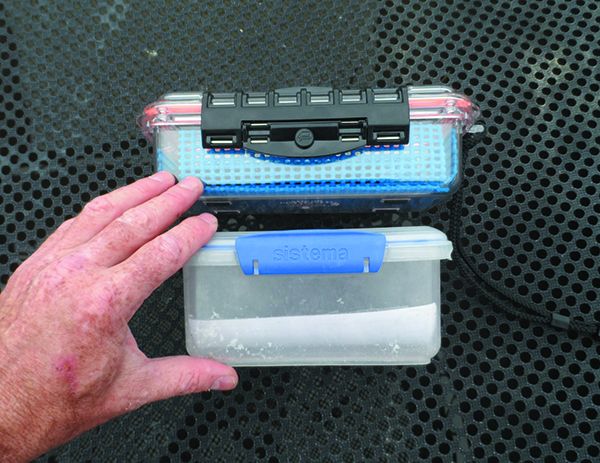
Observations
Forget your dry bags? We keep a few extra-heavy yard bags on the boat, such as the Husky 42 gallon, 3-mil Contractor Clean-Up Bags. These heavy-duty bags are far more tear-resistant than the common 1-mil yard bags.
You can also make your own liners. The Plano and Pelican mini dry boxes come with rubber liners to provide padding. These can trap water. Instead, cut a two-layer liner from a non-skid placemat. It fits snugly enough to stay in place, will dry with the lid open.
Check the seals. In our experiences, all dry boxes eventually fail when the O-ring becomes stiff or compressed.
Prices. We like to buy from locally owned stores (scuba shops, surf shops fishing stores, river sports shops, etc.), but you may save a few bones buying them online or from big box retailers.
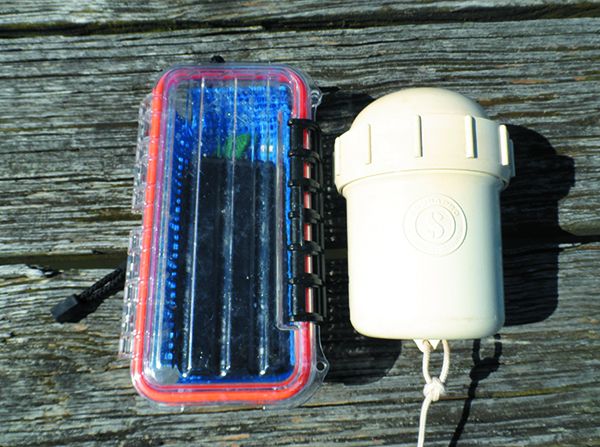
robust screw-type O-ring that seals better and is easier to replace.
Scuba Dry cannister
A plastic cylinder, with an O-ring seal and beefy threads, these are made by most scuba gear accessory companies and are basically identical. Typically rated for 40 meters submersion, they are absolutely watertight and bullet-proof durable. The problem is that most are too small for sailor use, suitable only for car keys and not cell phones.
We were lucky enough to find an unusually large canister from Scuba Pro 20 years ago, measuring 80 mm x 140 mm inside, as compared to the common 65 mm diameter canisters now available. As long as the O-ring is greased and the threads sprayed with wax every few years, these are virtually leak-proof. Different from dry boxes, the seal area is smaller and under strong compression, whereas dry boxes can begin to leak once the O-ring takes a compression set and sealing pressure declines. While every survey of dry boxes admits some leaks in kayak use, canisters only leak very deep under water. The 85 mm size holds smaller iPhones, while the 65 mm size is only suitable for keys and flip phones. The round canisters feel awkward because they do not sit flat, but they are just as fast to open and close as most catch systems. Maybe you can find a bigger one. $9-20.
Bottom line: Recommended for rough kayaking, paddle boarding, and other activities where you know you are going to get wet.
Sistema Klip 1-Liter
We grabbed these from the galley on a whim 5 years ago, just something to throw our phones and cameras in for the ride to the beach. We dropped them, rolled kayaks in white water, and left them in the water at the bottom of a kayak hundreds of times.
We never experienced a leak and it easily holds a smaller iPhone, camera, and keys. You don’t ordinarily think of leftovers containers as being durable, but these have held up well. We wouldn’t rate them as waterproof because of the light duty construction, but they are certainly very water repellent.
Perhaps you will only use these inside dry bags, where they will require far less space than a conventional dry box. We wouldn’t trust the larger sizes, a category better served by boxes from Pelican or equivalent brand. A box measuring 2.75” x 3.75” x 6” cost $12.
Bottom line: This is our Budget Buy. Raid the kitchen or check local retailers for something sturdy.
Plano 3500 Field Box
We felt the need to upgrade, perhaps just out of paranoia about the cost of phones, cameras, and electronic car keys, or just a feeling that we’d stretched our luck with food containers. We liked this better than the Plano box because of the over center latch and slightly increased size. After one season we’re quite pleased.
Bottom Line: Recommended.
See also “Dry Boxes,” Practical Sailor, April 2002.
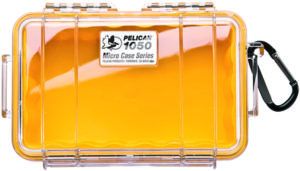
Pelican Mini-1050
This is the benchmark brand for this product line, and pricier than plain plastic storage boxes. Our only concern is the plastic hinge with a metal pin. We’ve had the plastic part crack, but it is wide and redundant—and covered by warranty.
Bottom line: Recommended.
Gill
The newest Gill bags represent a big upgrade from our 2001 test, during which the prototype bag submitted for testing leaked. The new production bags functioned as expected, no leaks, easy to use, and unscathed through a season of regular use. We like the rubbery fabric; it improves grip in wet conditions, makes snug rolling easy, and gives the bags good body.
The Gill Backpack is a great everyday boat bag. If it’s raining or gets dropped in the drink, so what? After a season of regular use and abuse, our test bag shows no visible wear and has never leaked a drop. The back and straps are padded, nicely shaped, and well-attached. We could add a sternum strap, but more straps mean more snags, and a on a pack this size we didn’t miss it. We wish the outside pocket was 100-percent waterproof, so we could use it for cell phone and electronic car keys, but that’s a small gripe. Electronic keys are safer in a small bag in the main compartment. At 35 liters, it is big enough without being cumbersome. In the bottom of the bag we carry a small tool and necessities bag, a handheld VHF, and spare water. Above that we pack clothes and lunch.
Gill’s cylinder-shaped stuff bags are simple and utilitarian. The 50-liter size comes with backpack straps for ease of carrying short distances, but it is not meant for long treks.
The duffel uses a roll-up closure. Because the roll-up includes a Velcro strip, most often only a ¾-roll will be used, through 1¾ rolls is safer. It includes reinforced carrying handles on the top and ends, multiple tie-down points, and a shoulder strap. It is a perfect crew bag for personal gear and extra clothes for overnights.
Bottom line: All three categories of the Gill products we tested are recommended for cruising sailors.
Practical Sailor has looked at various dry bags over the years, so our testers have had plenty of opportunity to explore what works and what doesn’t. This experience extends not only to the world of sailing, but also in the wide range of outdoor sports that our testers enjoy (kite boarding, kayaking, climbing, wind-surfing, backpacking, etc.).
Recent Practical Sailor reviews of various bags include:
“Dry Bag Backpack,” PS October 2005.
“A Slam Dunk,” PS December 2007.
“Boat Bags: Watershed, SealLine Dominate; West a Best Buy,” PS July 2001.
“Abandon Ship Bags: Don’t Leave the Boat Without Them.” PS February 2001.
- The Gill and Mantus backpacks design similarities are obvious. One difference is the material. The Gill is made of PVC, and the Mantus is mostly polyurethane. Each have pros and cons, and material alone is not the factor that will determine a bag’s long life or utility.
- The Gill dry bag stays dry inside. The zippered outside pocket is handy, but it leaked a few drops during testing. The pocket is described as water-resistant, not waterproof.
- With its webbing closure folded once ( a 1/2 turn), the Gill bag offers maximum volume. Testers found it kept out spray and rain with this closure. For extra measure, the closure can be folded multiple times, sacrificing a little volume with each fold.
- When packing dry bags, try to keep hardware and other hard objects in the middle. The fabric is tough, but why push it?
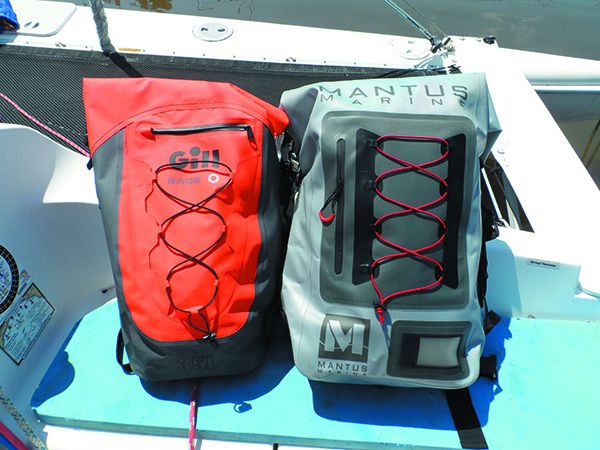
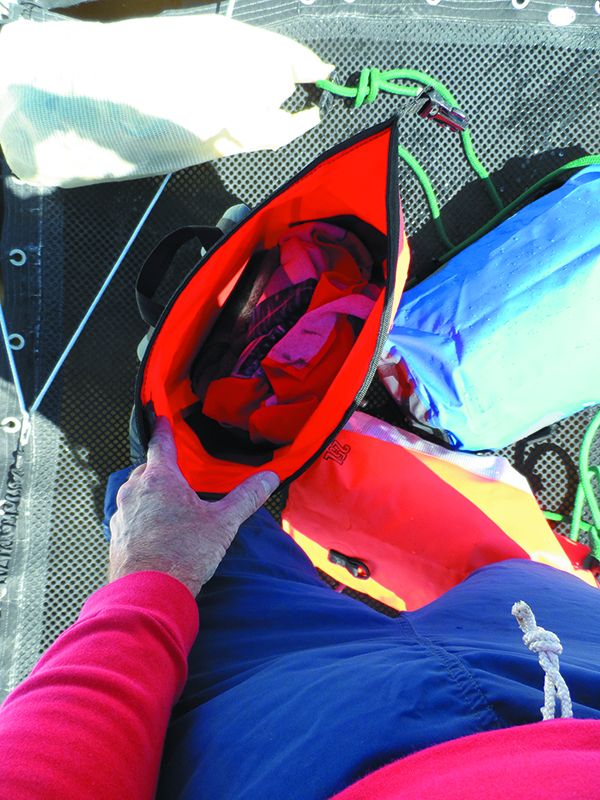
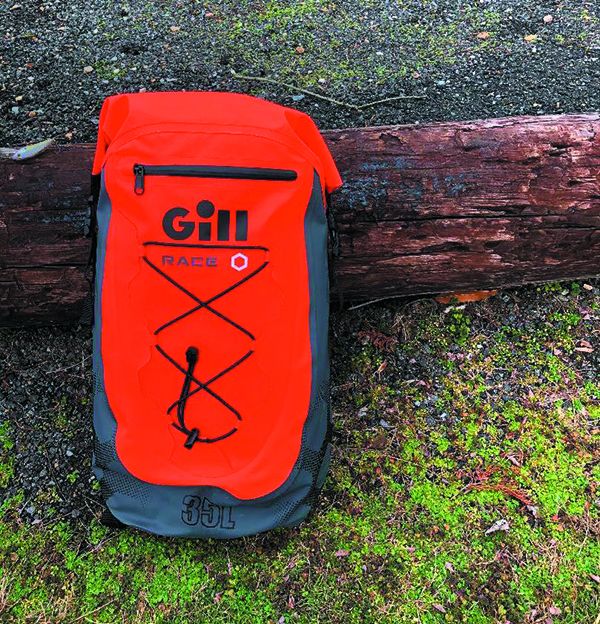
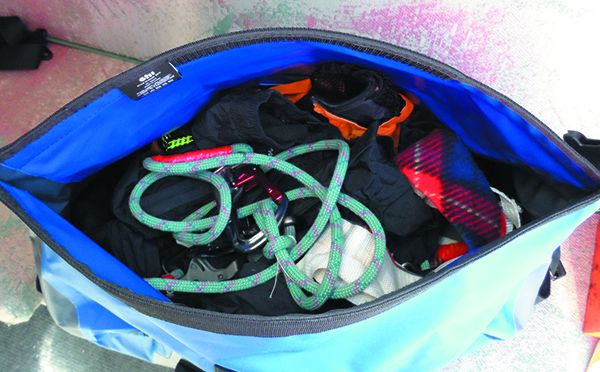
Cascade Designs
Our 1990s vintage bags have proven leak-proof for decades of intermittent use. Although we didn’t wear them out, it is reassuring that over 30 years the materials did not stiffen or turn sticky and that they are still fully functional. Under the new brand name, SealLine, they proved leak proof in the 2001 PS testing. The latest generation remains a good value.
Bottom line: Recommended by their long history in the market.
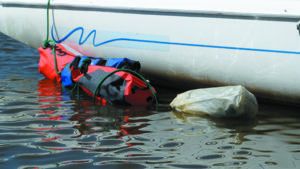
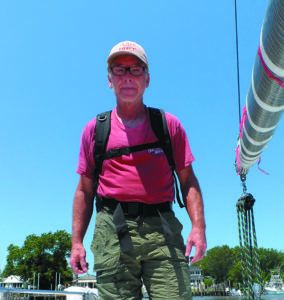
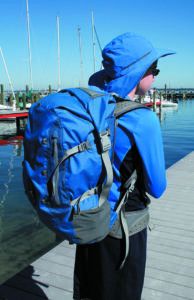
Watershed
The distinguishing feature of these well-made bags is their super-zip lock closure, which is completely waterproof. Although some of the Watershed bags combine this with a roll-top, the rolls are not required for watertight integrity. The open and close motion takes getting used to at first, but becomes second nature with practice. Downsides? These bags are a little pricier and bulkier. We want to distrust the closure, but we’ve not heard reports of failures.
Their product line includes every imaginable special purpose bag you can imagine, from backpacks and duffels, to deck bags and gun bags.
We tested the Chattanooga (22 liters). It combines a roll-up closure with a Watershed closure, providing watertight insurance. It has fewer handles and fittings than the Gill duffels, but is made from heavier fabric.
Bottom line: The Best Choice for perfect water tight integrity and extreme long life, though most sailors may actually be happier with the lighter weight and simplicity of Gill, Mantus, or Sea to Summit bags (previously tested, see “Gear Fit for Summer Sailing,” PS May 2015).
Mantus Backpack
Intended to carry heavy, bulky scuba gear, this is the largest and most rugged of the group. We used it to lug our heaviest loads of test gear back and forth, often breaking our own rules about careful packing of sharp objects. A sternum strap and waist belt help distribute the load. It also has a handy carrying handle. If you frequently sail in colder climates (below 40F) PVC has a tendency to stiffen.
Bottom line: Recommended for big, heavy loads.
Conclusions
None of these designs should let you down, although some are better than others, depending on your preferences. Back in the day, when we cruised in dinghies, beach cats, and kayaks, we appreciated 100-percent waterproof features. Our Cascade Designs bags would regularly see green water, get sat on, and lie in accumulated water. The only leaks came when they were overfilled and not rolled down twice, per the instructions.
For daysailors, or sport boat sailors the bag is used primarily for transporting stuff to and from the boat, either in the rain or via dinghy.
For people serious about a scuba diving and lugging around heavy gear, heavyweight bags like the Mantus or Gill rise to the top. But if you want a true backpack with hip support and padded shoulders, the Sea to Summit fits the bill.
None of the bags leaked, even after extremely long use. Our assumption is that they will remain watertight until punctured by a sharp object, torn by great force, or worn through by dragging on pavement. Treat them with any respect and they will likely last until you’re tired of looking at them. The Watershed bags have earned their reputation for being watertight and tough as nails, but unless you’re a whitewater rafting guide, you’ll never know the difference.





























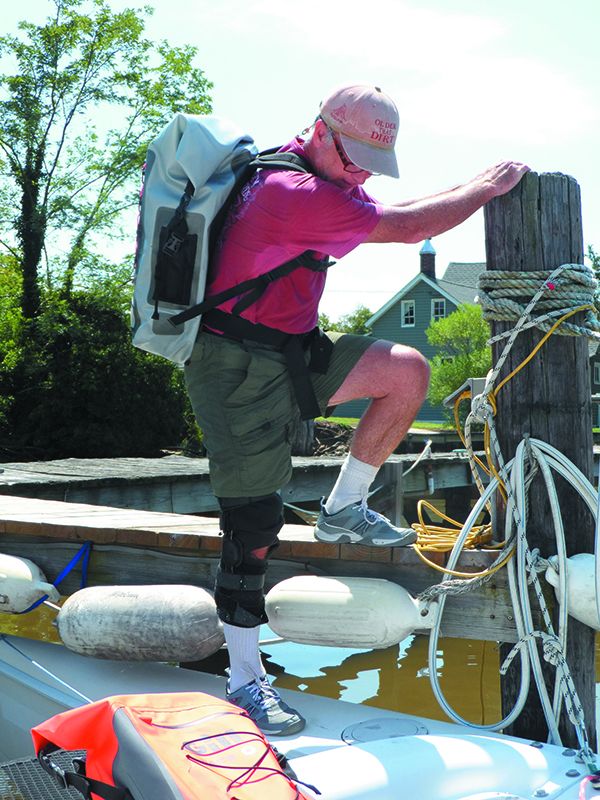




You should check out the Dry Case Masonboro 35L backpack. I’ve used one for years. Very well made with two internal pockets, molle webbing, and an external pocket.